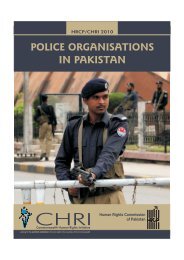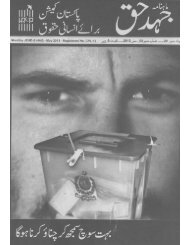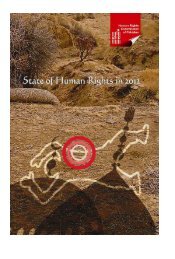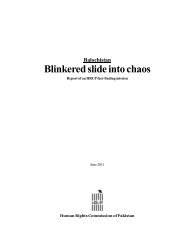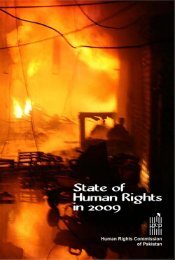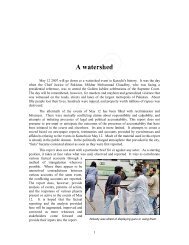Download PDF file - Human Rights Commission of Pakistan
Download PDF file - Human Rights Commission of Pakistan
Download PDF file - Human Rights Commission of Pakistan
- No tags were found...
Create successful ePaper yourself
Turn your PDF publications into a flip-book with our unique Google optimized e-Paper software.
130Revisiting Police LawsThe special features <strong>of</strong> the Order, 2002 are that:The Order gives the police autonomy in administrative and operational mattersPublic participation and external accountability through DPSCs and CPLCsBetter service delivery through internal reorganisation <strong>of</strong> the policeMore effective internal accountability through criminal actionAccording to Mr. Dogar the Order is an opportunity for change and an unprecedented impetus for improvementin police management and performance.Unfortunately, the current state <strong>of</strong> implementation is that:Provincial Public Safety <strong>Commission</strong>s are notified but not functionalDPSCs are neither complete nor functionalPolice have yet to be fully re-organised according to Region, City and Capital DistrictsSeparation <strong>of</strong> investigation from other functions at the police station has been stalledHowever, the procedures for change <strong>of</strong> investigation have been fully implemented.Problems with implementation <strong>of</strong> the OrderMr. Dogar stated there are many reasons for why the Order has not been implemented.Firstly, the Order is drafted like a policy document which is general in some areas making it difficult toimplement. Further, it presents a difficult scheme which is extremely broad in content. It aims to address issuesranging from <strong>Human</strong> Resource, Organisational Design and Law with out conceptual clarity. For instance, the commandand control mechanisms <strong>of</strong> the reorganised ‘matrix’ design are based on a business matrix with overlaps that do notgive the correct handles for control in a police force.A large part <strong>of</strong> the problem with the Order is that the National Reconstruction Bureau (NRB) that formulatedit did not take input from all <strong>of</strong> the stakeholders. As a result, the Order was created in a vacuum with very littledialogue. Hence, the issues that should have been resolved at formulation are being dealt with now. Due to the lack <strong>of</strong>inclusion <strong>of</strong> the provincial government and police there is a resultant lack <strong>of</strong> ownership <strong>of</strong> the Order by these twogroups which is necessary for the successful implementation <strong>of</strong> the reforms.Mr, Dogar also feels that the Order has faced a lot <strong>of</strong> resistance due to the organisational and personalresistance to change displayed repeatedly by <strong>Pakistan</strong>’s institutions, coupled with the psychological barriers <strong>of</strong> thosewith influence. Further, the poor awareness <strong>of</strong> the law by the citizens <strong>of</strong> <strong>Pakistan</strong> also makes them a less powerfultool for change.The Police Order is based on the devolution scheme which left many in the provincial government indifferentor even hostile to the Order as legislators lost control <strong>of</strong> funds and the PSCs posed as rivals to provincial government’scontrol over the police force.In addition, the police are a rigidly hierarchical organisation bound by a culture <strong>of</strong> conformity and submissionwith a high resistance to change in all forms. There are physical and infrastructure constraints on the quality <strong>of</strong>training that the police can receive in order to successfully absorb change. Despite considerable expansion over thepast 3 years there are major constraints in human resource that is needed to effectively implement the reforms. As anindication <strong>of</strong> the shortage <strong>of</strong> effective personnel in the police there is only 1 Investigations Officer for every 50 cases.The greatest stumbling block for senior police <strong>of</strong>ficers in absorbing the new law is the separation <strong>of</strong> investigationfrom watch and ward functions. The Order presents a matrix organisational structure without clear horizontal andvertical reporting relationships leaving <strong>of</strong>ficials uncertain with regards to ‘their own hierarchy’. The confusion in thelaw is exacerbated by poor follow-up legislation and rule-making. For example, no rules have been framed for thePublic Safety <strong>Commission</strong>s and CPLCs which could serve as effective oversight bodies <strong>of</strong> police behaviour.Finally, Mr. Dogar stated that the most fundamental problem in the implementation <strong>of</strong> the Order was the



